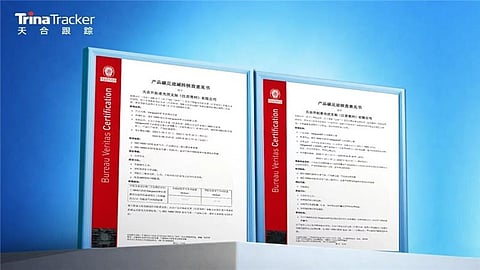

TrinaTracker, the tracker manufacturing arm of Trinasolar, has obtained Product Carbon Footprint (PCF) Certification for its Vanguard 2P tracker and PCF Reduction Verification for Vanguard 1P from Bureau Veritas. The company says that the entire Vanguard series has now been independently verified for carbon performance. The ISO 14067:2018-based certification for Vanguard 2P covers the cradle-to-gate lifecycle, recognizing the company’s use of low-carbon materials, optimized logistics, and energy-efficient manufacturing. It adds that the Vanguard 1P achieved over a 10% reduction in greenhouse gas emissions within a year through design and process improvements. Trina highlighted that these certifications provide transparent carbon data aligned with international standards, reflecting its commitment to reducing emissions across sourcing, production, and logistics, and supporting customers in meeting tightening carbon regulations.
In July, TrinaTracker was awarded China’s first third-party review report for wind tunnel testing in the solar tracker sector, issued by DNV (see China Solar PV News Snippets).
Chinese inverter and energy storage giant Sungrow has submitted a draft prospectus to the Hong Kong Stock Exchange. While the document does not disclose the details, it outlines that the company intends to use the proceeds to construct a next-generation R&D center for PV and storage products, as well as to invest in digitalization and intelligent manufacturing. The plan also includes establishing several overseas production bases with a combined manufacturing capacity of 18 GWh of energy storage systems and 30 GW of inverters.
While details of the overseas factories were not specified in the filing, Sungrow’s Chairman, Cao Renxian, mentioned in a meeting with Egyptian President Abdel Fattah el-Sisi in September that the company plans to build a 10 GWh energy storage cell factory in Egypt.
As of June 30, 2025, Sungrow’s manufacturing capacity stood at 169 GW of inverters (119 GW in China, 50 GW overseas) and 28 GWh of energy storage systems in total.
Sungrow reported 40.34% YoY growth in its operating income for H1 2025 (see Sungrow Power Posts Over 40% YoY Revenue Growth in H1 2025).
Haikong Sanxin (Bengbu) New Energy Materials Co., Ltd., a PV glass subsidiary of Hainan Development, ceased operations at the end of September 2025 and is preparing to apply for bankruptcy liquidation.
The company, specializing in ultra-clear solar glass, has suffered continuous losses since 2022 due to increased competition and prolonged price declines in the PV glass market. As of June 30, 2025, its net assets stood at negative RMB 159.52 million ($22.25 million), indicating insolvency. To mitigate further losses, Hainan Development’s board has approved a proposal for bankruptcy liquidation.
According to data from China's New Energy Consumption Monitoring and Early Warning Center, the country’s solar PV power utilization rate in August 2025 was 96.4%, unchanged from July (see China Solar PV News Snippets). Wind power utilization declined slightly to 96.6%, compared to 97% in July.
For the January to August period, China’s average PV utilization rate stood at 94.9%, while wind power recorded 94.1%, both lower than the 97.2% and 96.4% respective utilization rates reported for the same period in 2024.
Yunnan Province has issued new management rules for distributed solar PV generation. For residential PV projects under 6 MW, owners can freely choose between self-consumption and grid sales without restriction.
For industrial and commercial (C&I) PV projects under 6 MW, those built on public institutions must ensure at least 30% self-consumption, while projects on C&I rooftops must achieve no less than 50% self-consumption.
Large-scale distributed PV systems with voltage levels of 35 kV (6-20 MW) or 110 kV (6-50 MW) are, in principle, required to consume 100% of the power generated. Exceptions apply only when the Southern regional power spot market operates continuously; in such cases, large distributed PV projects may adopt a self-consumption with surplus grid feed-in model to participate in market trading.
